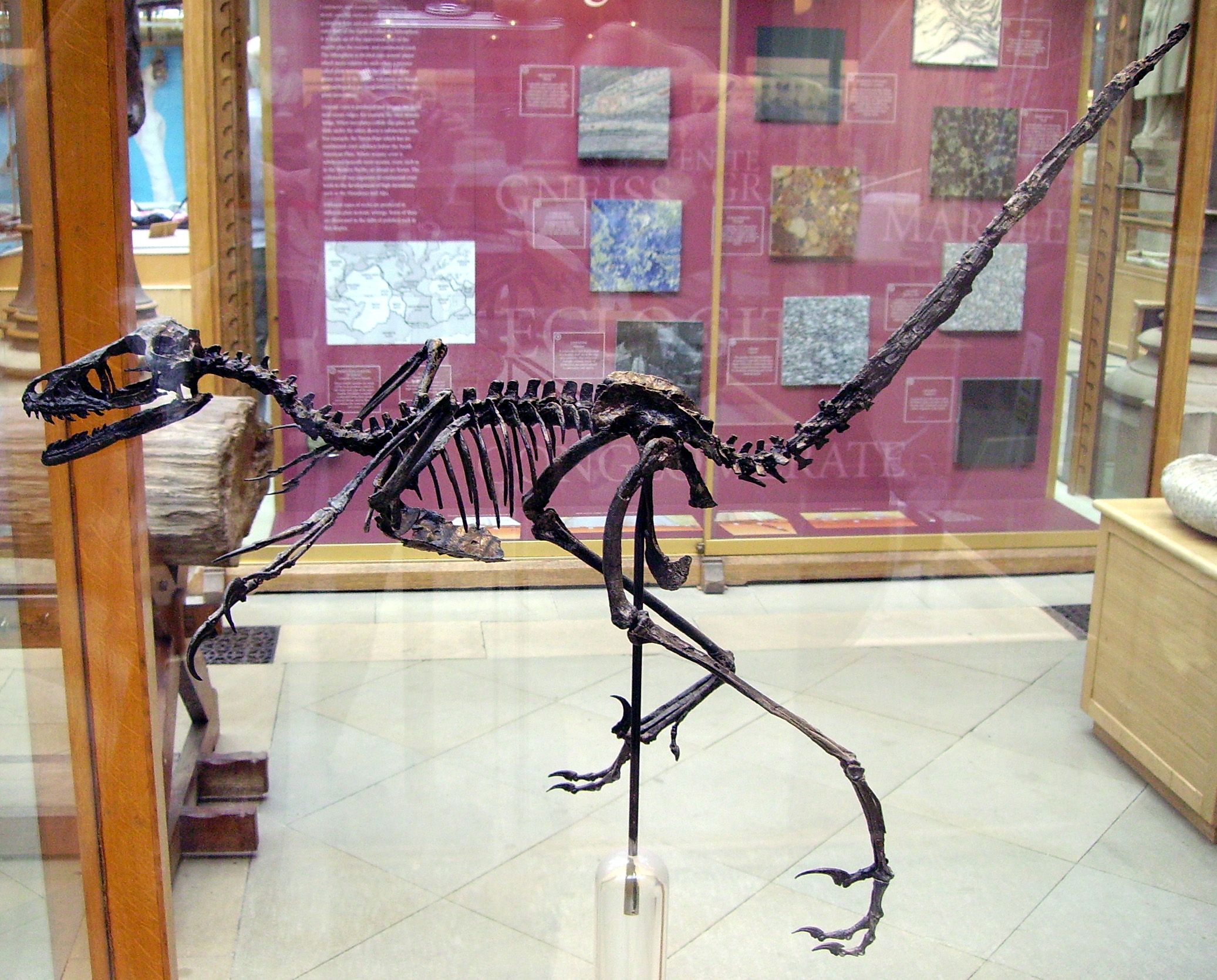- Bambiraptor
Taxobox|
name = "Bambiraptor"
fossil_range =Late Cretaceous

image_caption = "Bambiraptor" skeleton in theOxford University Museum of Natural History .
regnum =Animal ia
phylum = Chordata
classis = Sauropsida
superordo =Dinosaur ia
ordo =Saurischia
subordo =Theropoda
familia =Dromaeosauridae
genus = "Bambiraptor"
genus_authority = Burnham "et al.", 2000
subdivision_ranks =Species
subdivision = "B. feinbergi" Burnham "et al.", 2000 (type)"Bambiraptor" is a 75 million year old bird-like
dinosaur discovered by scientists at theUniversity of Kansas ,Yale University , and theUniversity of New Orleans . When living, "Bambiraptor" would have stood no more than 0.3 meter (1 ft) off the ground, reached 0.7 meter (2.3 ft) in length, and weighed only two kilograms (4.4 lb), although this specimen appears to be a juvenile [http://www.amnh.org/exhibitions/dinosaurs/intro/newspecies.php] ,it is therefore certainly possible that "Bambiraptor" is really just a juvenile "Saurornitholestes ", but no one can be positive. Because of its small size, it was christened "Bambiraptor feinbergi", after the familiar Disney movie character and the surname of the wealthy family who bought and donated the specimen to the new Graves Museum of Natural History inFlorida . The "Bambiraptor" skeleton was discovered in 1995 by 14-year-old fossil hunterWes Linster , who was looking for dinosaur bones with his parents near Glacier National Park inMontana . Linster told "Time Magazine " that he uncovered the skeleton on a tall hill and was amazed at his discovery. "I bolted down the hill to get my mom because I knew I shouldn't be messing with it", he said. The bones that Linster discovered on that hilltop led to the excavation of a skeleton that was approximately 95 percent complete. Because of its completeness Florida Paleontology Institute Director Martin Shugar compared it to the 'Rosetta Stone ' that enabled archaeologists to translate Egyptian hieroglyphics. Yale paleontologistJohn Ostrom , who reintroduced the theory of bird evolution from dinosaurs after his1964 discovery of "Deinonychus " inWyoming , agreed, calling the specimen a "jewel", and telling reporters that the completeness and undistorted qualities of the bones should help scientists further understand the dinosaur-bird link. The specimen is currently housed at theAmerican Museum of Natural History , New York.During the conference where "Bambiraptor" was first introduced, the dinosaur reconstruction specialist Brian Cooley portrayed "Bambiraptor" as having
feathers , despite the fact that no feathers were found with the fossil itself. His decision was influenced by the fact that because "Bambiraptor" within a cladistic analysis was a member of a group,Paraves , that contained feathered truebirds and that was the sister taxon ofOviraptorosauria , a group that also had feathered forms (e.g. "Caudipteryx "), "Bambiraptor" most likely had feathers too due to phylogenetic bracketing. Most paleontologists support Cooley's view, and subsequent discoveries confirmed that small dromaeosaurid dinosaurs like "Bambiraptor" were fully covered in feathers (seeDromaeosauridae for more information).Research done at
Lamar State College inOrange, Texas has indicated that "Bambiraptor" may have had opposable front claws and a forelimb maneuverability that could reach its mouth. This would have given the animal the ability to "hold" food in its front limbs and place it in its mouth, in a similar manner to some modern-day small mammals. [http://www.newscientist.com/article.ns?id=dn11047] "Bambiraptor" had a brain size in the lower range of modern birds. Because of its enlargedcerebellum , which may indicate higher agility and higher intelligence than other dromaeosaurs, David A. Burnham has hypothesized that "Bambiraptor feinbergi" may have been arboreal. Life in the trees may have required evolutionary pressure that resulted in a larger brain. Burnham also offers an alternative hypothesis that a larger brain could be selected for as a result of hunting more agile prey items such as lizards and mammals. Bambiraptor had the largest brain for its size of any dinosaur yet discovered, although the brain size may be due to its age, because juvenile animals tend to have larger brain-to-body ratios compared to adults. It also had very long arms and a well-developed wishbone.References
*
External links
* [http://www.dinodata.org/index.php?option=com_content&task=view&id=6156&Itemid=67 "Bambiraptor"] at DinoData
* [http://www.oum.ox.ac.uk/learning/pdfs/dinosaur.pdf Details of the Oxford University Museum of Natural History exhibit (page 8)]
Wikimedia Foundation. 2010.
